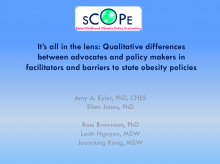We are pleased to announce an exciting new alliance between Active Living Research and GP RED to co-host and coordinate...
It's All in the Lens: Qualitative Differences between Advocates and Policy Makers in Facilitators and Barriers to State Obesity

Presentation at the 2011 Active Living Research Annual Conference
Background:
In response to the child obesity epidemic, there is a focus on identifying effective policy interventions to reverse this epidemic by 2015. In recent years, states have introduced and adopted legislation that focuses on obesity prevention in youth in both school and community settings. However, states differ in both the quantity and quality of this legislation. Few studies have documented differences and similarities among perceptions of legislators, advocates, and governors.
Objectives:
The objective of this study is to examine qualitative factors that influence childhood obesity legislation in states with highest number of laws related to childhood obesity prevention
Methods:
Methods: In order to identify states with high levels of childhood obesity policy action, a legislative database was searched for legislation in sixteen topic areas: nutrition and vending standards, health and PE credit, BMI reporting, safe routes to school, local authority, model school policies, taskforces, farmer’s markets, farm to school programs, walking and biking trails, menu and product labeling, soda and snack taxes, and childcare physical activity and nutrition standards. States were given a score based on the total number of bills enacted within these categories, and identified as high policy action states. The team developed an interview guide for both policy makers and advocates. Phone interviews were conducted in six states with legislators on health committees, advocates, and representatives from Governor’s offices. The interviews were transcribed, coded and analyzed.
Results:
Results: Results were analyzed independently and compared across each group (legislators, advocates, governor’s office representatives). Twenty-three policy makers and twenty-five advocates were interviewed. The states represented in the studies included WA, ME, LA, NY, OK, CO, SD, MT, AZ and KS. The main themes arising from interviews with policy makers were importance of local context, unclear evidence-base, and discomfort with role of the legislature in childhood obesity policy. For advocates, issues included coordination of statewide policy efforts, consensus on an advocacy plan and priorities, and relationships with policy makers. The main similarities among the two groups interviewed were organization of efforts and nurtured relationships. Differences were identified within the topics of strength of evidence, advocacy tools, and role of the legislature in childhood obesity policy.
Conclusions:
Conclusion: Understanding the policy process is an essential step in enacting evidence-based interventions that may prevent childhood obesity and improve health. This qualitative study adds to this understanding across three different groups who influence state policy in various ways. Lessons were learned from states where childhood obesity legislation has been proposed and successfully passed. Maybe give one example. Sharing the perceptions of advocates in these states with advocates trying to introduce or pass legislation will facilitate understanding of facilitators and barriers to enactment of childhood obesity legislation and help enhance communication with state policy makers. Results provide a more robust understanding of state level policy interventions that contribute to childhood obesity prevention and improve overall public health.
Support:
Support: This project is funded by the Robert Wood Johnson Foundation agreement #65559. Project title: Examination of State Childhood Obesity Prevention Policies.
STAY UP TO DATE
RECENTLY ADDED TOOLS & RESOURCES
MOVE! A BLOG ABOUT ACTIVE LIVING
The "Active Living Conference" aims to break down research and practice silos and...







